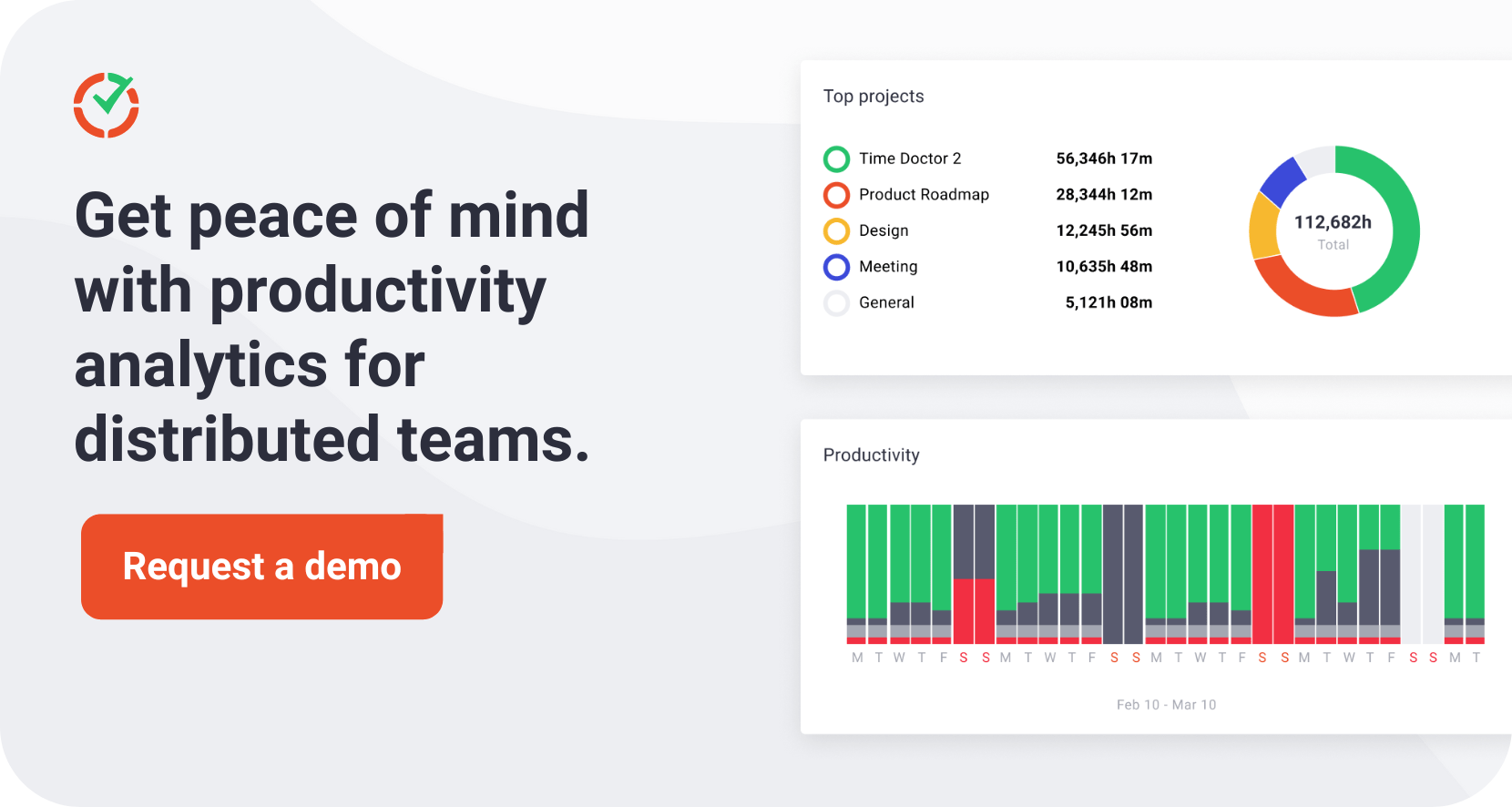36
Although we’re eager to move past the COVID-19 pandemic, it’s impossible to separate the events of the last few years from the rapid rise in employee monitoring software adoption. As companies worldwide suddenly and unexpectedly found themselves working remotely, employee monitoring software became a way to manage the transition.
Companies wanted to ensure their people were working when they were supposed to be working. Unfortunately, the whiplash-inducing speed of the transition led many organizations to implement rigid employee monitoring systems that modeled traditional approaches.
Thankfully, we’re now seeing leaders in employee engagement start to evolve their approaches. Compliance is giving way to continuous improvement as managers seek more ethical and effective ways to track employee performance.
Improvement-focused monitoring is designed to be collaborative and constructive, providing the support employees need to succeed, instead of creating a culture of control. Managers can use data to work with employees towards improving organizational performance instead of upholding an outdated mindset of catching out devious behavior.
The differences between traditional and improvement-focused employee monitoring start at the fundamentals and carry through to the function and features.
Fundamental purpose
Traditional monitoring is used to control and supervise employees in organizations that view workers as expendable resources.
Improvement-focused monitoring is used to identify areas for improvement and provide support for employees to do their best work.
Functional differences
Traditional monitoring is often intrusive and secretive, characterized by stringent oversight, rigid performance metrics, and close monitoring of employees’ activities without regard for personal context.
Improvement-focused monitoring is transparent and collaborative, positioning employees as partners in their own development and using data to link individual contributions to organizational success.
Features and impact
Traditional monitoring prioritizes compliance above excellence, leading to decreased productivity and creativity.
Improvement-focused monitoring accounts for individual contexts, involving employees in the data gathering and reporting processes, giving them greater ownership and encouraging personal development.
The benefits of strategic improvement-focused monitoring
Improvement-focused monitoring is a more ethical approach to productivity. Although it fundamentally addresses the same problems of visibility and continuous improvement, the empathetic approach means everybody wins.
Identify resourcing issues
Rather than focusing on cost-cutting initiatives, improvement-focused monitoring highlights opportunities to redistribute resources more effectively. Pain points like bottlenecks and time-consuming tasks become problems impacting product quality, client satisfaction and employee overwork. Solutions are designed with these outcomes in mind.
Reward based on merit
When the New York Times looked into the rise of employee monitoring, one conclusion they drew was that data is meritocratic. For example, several women interviewed for the piece wanted to work in an environment where “rewards are not based on who is schmoozing with who or who is going out drinking with who, but instead on who is really being industrious”. They felt monitoring leveled the playing field.
Proactively manage productivity problems
Time Doctor users Comparakeet provide a stellar example of improvement-focused monitoring in action. When the founders noticed one employee was editing timesheets, they delved into the data to understand what was happening. The founders then worked with the employee to correct course, using productivity data to implement and measure a collaborative solution.
Transform operations
Employee monitoring has undoubtedly become more prolific with the rise of distributed work. Workday analytics is a huge boon for remote managers, at least functionally. What’s still evolving is the philosophy. This is where improvement-focused monitoring, as opposed to monitoring for the sake of monitoring, becomes an all-important enabler in the transition.
The cost of a compliance mindset
Unfortunately, Traditional employee monitoring has fallen short of its aims to enhance productivity and efficiency. The rigid systems reduce employees to productive minutes, leading to decreased job satisfaction, increased stress, and a lack of trust between employees and employers. The psychological toll of constant scrutiny kills creativity and erodes overall well-being.
- Workers who have low control over their jobs report higher rates of depression and anxiety, plus headaches, sleep problems, and other physical ailments.
- Over 70% of Americans would turn down a job if they learned the employer spied on staff.
We know engaged employees are up to 23% more profitable and 18% more productive. Employee monitoring software certainly contributes; one MIT study found that revenue increased by 7% when workers knew they were being monitored. But more than anything else, transparency and trust are the hallmarks of modern employee monitoring.
Practical steps to make the switch from surveillance to collaboration
Identify the core concerns
In a survey of 20,000 people across 11 countries, Microsoft found that 85% of managers found it challenging to trust that remote and hybrid employees are productive. Part of the problem was that 54% of in-person managers reported having visibility into the work their employees were doing, while only 38% of hybrid managers said the same.
Employee monitoring software is an effective lens to gain visibility into performance. However, managers still need to work on evolving the organizational mindset to see the full benefit.At the heart of improvement-focused monitoring is a shared organizational goal of continuous improvement.
What will managers and employees do with that data? How will it help to grow the organization? What are the current blind spots in existing business systems? Answering these questions helps to educate leadership and employees about the benefits of improvement-focused monitoring and align the team behind shared goals.
Assess your monitoring needs
Every organization is unique. The transition to improvement-focused monitoring and the tools used to implement the change should fit your specific needs.
For example, managers at AI unified communication platform Sarv faced twin challenges in maintaining remote team accountability and preventing burnout from affecting their people. By implementing Time Doctor, Sarv gained access to detailed workday data, including work-life balance metrics, enabling managers and employees to analyze performance on both fronts so team members weren’t prioritizing work over health.
On the other hand, NY-based Purity Products wanted to validate their employees’ timesheets and provide training for employees who need help navigating the company’s systems. Purity Products gains the greatest value from Time Doctor’s timesheet features and regular screenshots, both of which enable managers and employees to proactively address employee concerns.
Employee monitoring software like Time Doctor provides crystal-clear access to a huge volume of workday data. Defining the areas that matter most to your organization’s success will help tailor your monitoring approach.
Now we’re ready to implement employee monitoring software
1. Assess current practices
Conduct an internal audit of current monitoring methods. Identify surveillance-heavy processes and their impact on employee morale and productivity.
2. Set clear goals
Define specific goals for improvement. Focus on objectives that empower employees and foster collaboration, such as skill development, problem-solving, and innovation.
3. Choose the right tools
Select monitoring tools that align with your new approach. Look for systems that allow for employee self-assessment, feedback and active participation.
4. Communicate often and honestly
Maintain open and transparent communication. Explain the reasons for the shift and how it benefits both employees and the organization, and be ready for questions.
5. Legal and regulatory compliance*
Ensure the new monitoring approach complies with relevant laws and regulations, especially data protection and employees’ rights to privacy or information.
6. Pilot program
Start with a small-scale pilot program involving a select group of employees. Gather feedback and fine-tune the approach based on their experiences.
7. Adapt and scale
Tweak the monitoring approach as it’s rolled out across the business to ensure it doesn’t become rigid or irrelevant.
8. Provide resources
Ensure employees have access to the necessary training, tools and support to thrive in the new monitoring environment.
9. Monitoring guidelines
Develop clear guidelines and expectations for employees regarding self-assessment, goal-setting, and collaboration. Encourage regular check-ins and progress reviews.
10. Continuous improvement
Continuously assess and refine the new monitoring process. Solicit employee feedback and make adjustments to address any challenges or issues.
Sustaining improvement and trust
The switch from surveillance to collaboration can be tricky to maintain, especially when people are busy managing daily tasks. It’s easy to focus on productivity metrics in isolation and forget there’s a broader context for improvement-focused monitoring.
Maintain regular check-ins
Managers can use workday data as the launch pad for productive one-on-one conversations about an employee’s progress, challenges and career development. These meetings are an opportunity to build trust, provide guidance and demonstrate affirmative action.
Invest in effective training
Continue investing in employee development to support their growth and enhance their ability to contribute effectively. Just as Purity Products did, you can use employee monitoring software to assess an individual’s capabilities and tailor training to their needs.
Recruit collaboration champions
Organizational leaders must remain committed to the new approach. It’s important that employees know their efforts aren’t taken for granted. Unfortunately, less than one-third (30%) of US employees believe their inputs count at work, and 31% receive recognition for a job well done.
Legal and privacy considerations
The legal and privacy requirements for employee monitoring vary from country to country, and there are additional steps if you’re tracking international teams.
USA
The Electronic Communications Privacy Act of 1986 (ECPA) is a federal law protecting the privacy of electronic communications. The ECPA allows businesses to monitor verbal and written communication (with a legitimate business reason), and there is further scope to monitor other activity with consent. When it comes to company-owned computers, employers are allowed to monitor web activity as long as they respect relevant privacy laws.
Some US states have more restrictive laws than the ECPA, while others have less restrictive laws.
Europe
The EU doesn’t have specific regulations for employee monitoring. Most companies use The General Data Protection Regulation (GDPR), an EU law that protects personal data privacy. GDPR applies to all businesses that process the personal data of individuals in the EU, regardless of where the company is located.
The GDPR requires businesses to obtain consent from individuals before collecting or processing their personal data, and companies must perform a Privacy Impact Assessment before implementing tracking software.
Australia
No specific law covers employee monitoring, so companies should refer to relevant local, State and Federal laws for guidance. Employers can usually install monitoring software on company computers, provided they notify the employee at least 14 days in advance.
UK
The Data Protection Act 2018 (DPA) allows employers to monitor employee activity with consent. The DPA sets out guidelines for employee monitoring, including clear communication in the employment contract and specifying whether personal calls and emails are monitored.
Conclusion
The shift towards improvement-focused employee monitoring marks a significant evolution in the way organizations approach productivity and employee engagement. This progressive model, emerging in the wake of the pandemic’s challenges, recognizes the value of transparency, trust, and collaboration.
By prioritizing employee development and well-being, improvement-focused monitoring not only enhances productivity but also fosters a more ethical and supportive workplace culture. As we move forward, it’s clear that the success of remote work and the health of organizational environments hinge on this empathetic and strategic approach.
Employers and employees alike stand to benefit from this paradigm shift, which promises to redefine the boundaries of work and productivity in the modern age.

Carlo Borja is the Head of Content Marketing for Time Doctor, a productivity analytics software for distributed teams. He is a remote work advocate, a father and a coffee junkie.



